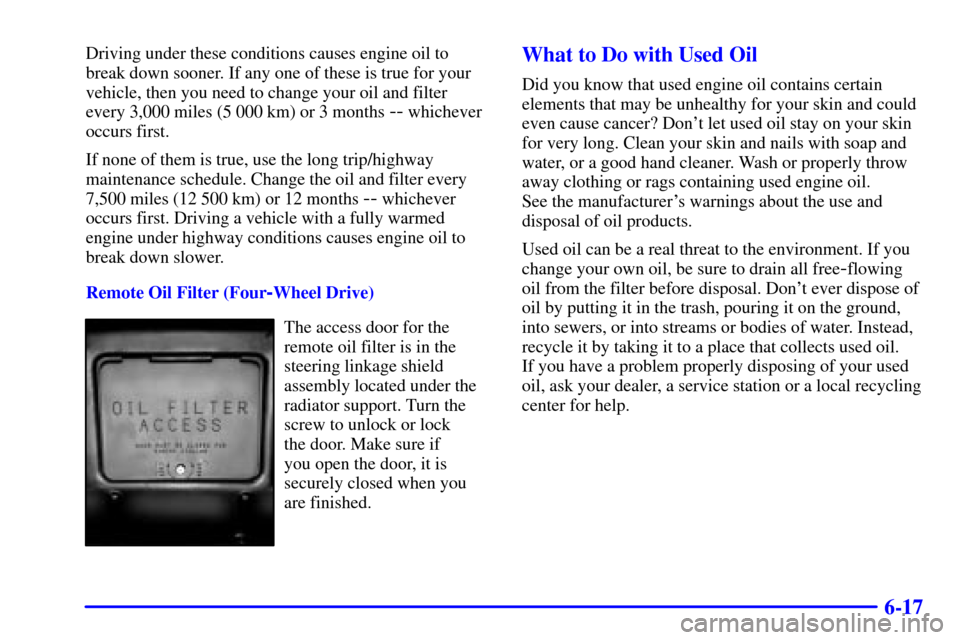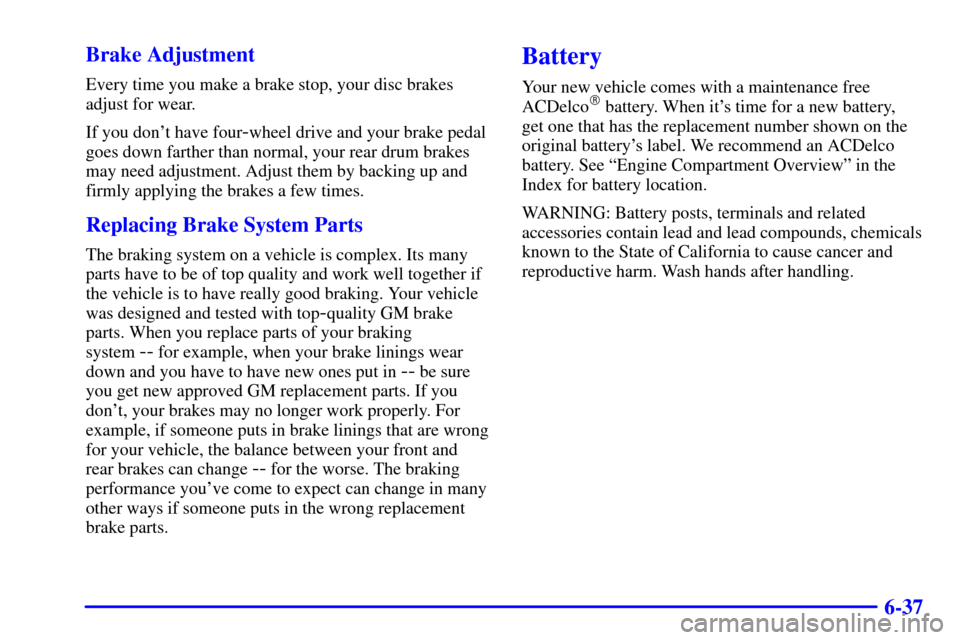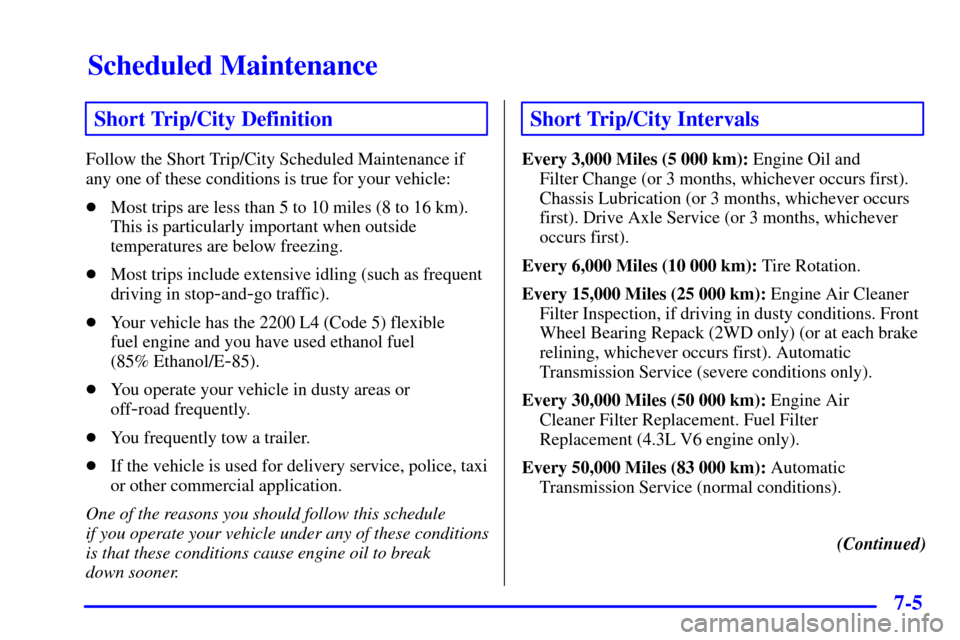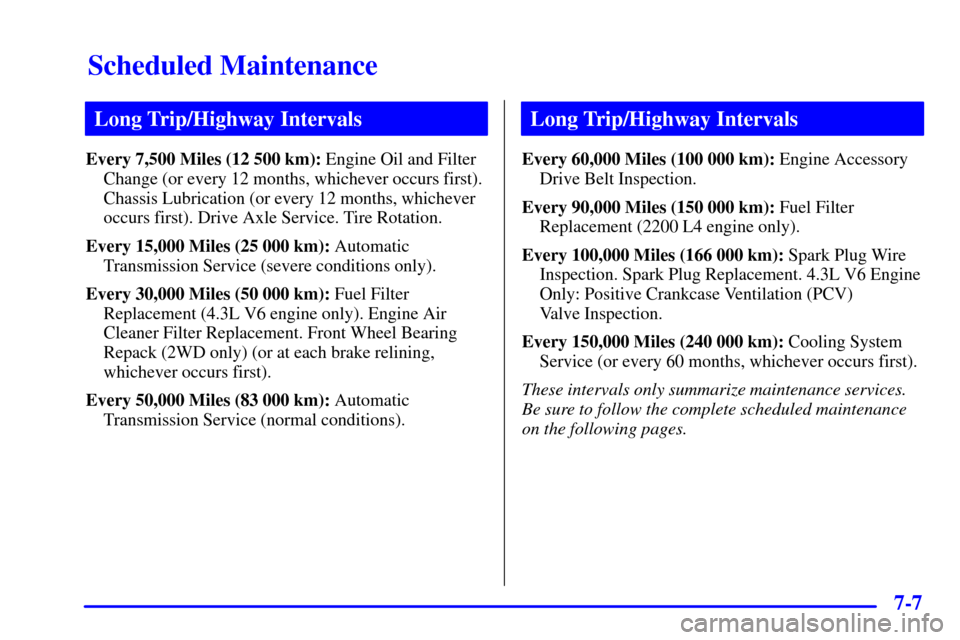Page 251 of 407
5-18
Changing a Flat Tire
If a tire goes flat, avoid further tire and wheel damage
by driving slowly to a level place. Turn on your hazard
warning flashers.
CAUTION:
Changing a tire can cause an injury. The vehicle
can slip off the jack and roll over you or other
people. You and they could be badly injured.
Find a level place to change your tire. To help
prevent the vehicle from moving:
1. Set the parking brake firmly.
2. Put an automatic transmission shift lever in
PARK (P) or shift a manual transmission to
FIRST (1) or REVERSE (R).
3. Turn off the engine.
4. Put the wheel blocks at the front and
rear of the tire farthest away from the
one being changed. That would be the
tire on the other side of the vehicle, at
the opposite end.The following steps will tell you how to use the jack and
change a tire.
Page 257 of 407
5-24
6. Remove any rust or dirt
from the wheel bolts,
mounting surfaces and
spare wheel.
CAUTION:
Rust or dirt on the wheel, or on the parts to
which it is fastened, can make the wheel nuts
become loose after a time. The wheel could come
off and cause an accident. When you change a
wheel, remove any rust or dirt from the places
where the wheel attaches to the vehicle. In an
emergency, you can use a cloth or a paper towel
to do this; but be sure to use a scraper or wire
brush later, if you need to, to get all the rust or
dirt off.
CAUTION:
Never use oil or grease on studs or nuts. If you
do, the nuts might come loose. Your wheel could
fall off, causing a serious accident.
7. Place the spare on the wheel mounting surface.
8. Put the nuts on by
hand. Make sure
the cone
-shaped
end is toward
the wheel.
Tighten each nut by hand until the wheel is held
against the hub. If a nut can't be turned by hand,
use the wheel wrench and see your dealer as soon
as possible.
Page 282 of 407

6-17
Driving under these conditions causes engine oil to
break down sooner. If any one of these is true for your
vehicle, then you need to change your oil and filter
every 3,000 miles (5 000 km) or 3 months
-- whichever
occurs first.
If none of them is true, use the long trip/highway
maintenance schedule. Change the oil and filter every
7,500 miles (12 500 km) or 12 months
-- whichever
occurs first. Driving a vehicle with a fully warmed
engine under highway conditions causes engine oil to
break down slower.
Remote Oil Filter (Four
-Wheel Drive)
The access door for the
remote oil filter is in the
steering linkage shield
assembly located under the
radiator support. Turn the
screw to unlock or lock
the door. Make sure if
you open the door, it is
securely closed when you
are finished.
What to Do with Used Oil
Did you know that used engine oil contains certain
elements that may be unhealthy for your skin and could
even cause cancer? Don't let used oil stay on your skin
for very long. Clean your skin and nails with soap and
water, or a good hand cleaner. Wash or properly throw
away clothing or rags containing used engine oil.
See the manufacturer's warnings about the use and
disposal of oil products.
Used oil can be a real threat to the environment. If you
change your own oil, be sure to drain all free
-flowing
oil from the filter before disposal. Don't ever dispose of
oil by putting it in the trash, pouring it on the ground,
into sewers, or into streams or bodies of water. Instead,
recycle it by taking it to a place that collects used oil.
If you have a problem properly disposing of your used
oil, ask your dealer, a service station or a local recycling
center for help.
Page 302 of 407

6-37 Brake Adjustment
Every time you make a brake stop, your disc brakes
adjust for wear.
If you don't have four
-wheel drive and your brake pedal
goes down farther than normal, your rear drum brakes
may need adjustment. Adjust them by backing up and
firmly applying the brakes a few times.
Replacing Brake System Parts
The braking system on a vehicle is complex. Its many
parts have to be of top quality and work well together if
the vehicle is to have really good braking. Your vehicle
was designed and tested with top
-quality GM brake
parts. When you replace parts of your braking
system
-- for example, when your brake linings wear
down and you have to have new ones put in
-- be sure
you get new approved GM replacement parts. If you
don't, your brakes may no longer work properly. For
example, if someone puts in brake linings that are wrong
for your vehicle, the balance between your front and
rear brakes can change
-- for the worse. The braking
performance you've come to expect can change in many
other ways if someone puts in the wrong replacement
brake parts.
Battery
Your new vehicle comes with a maintenance free
ACDelco� battery. When it's time for a new battery,
get one that has the replacement number shown on the
original battery's label. We recommend an ACDelco
battery. See ªEngine Compartment Overviewº in the
Index for battery location.
WARNING: Battery posts, terminals and related
accessories contain lead and lead compounds, chemicals
known to the State of California to cause cancer and
reproductive harm. Wash hands after handling.
Page 314 of 407

6-49
If your vehicle has a compact spare tire, don't include it
in your tire rotation.
After the tires have been rotated, adjust the front and
rear inflation pressures as shown on the
Certification/Tire label. Make certain that all wheel nuts
are properly tightened. See ªWheel Nut Torqueº in
the Index.
CAUTION:
Rust or dirt on a wheel, or on the parts to which
it is fastened, can make wheel nuts become loose
after a time. The wheel could come off and cause
an accident. When you change a wheel, remove
any rust or dirt from places where the wheel
attaches to the vehicle. In an emergency, you
can use a cloth or a paper towel to do this;
but be sure to use a scraper or wire brush later,
if you need to, to get all the rust or dirt off.
See ªChanging a Flat Tireº in the Index.
When It's Time for New Tires
One way to tell when it's
time for new tires is to
check the treadwear
indicators, which will
appear when your tires have
only 1/16 inch (1.6 mm) or
less of tread remaining.
You need a new tire if any of the following statements
are true:
�You can see the indicators at three or more places
around the tire.
�You can see cord or fabric showing through the
tire's rubber.
�The tread or sidewall is cracked, cut or snagged deep
enough to show cord or fabric.
�The tire has a bump, bulge or split.
�The tire has a puncture, cut or other damage that
can't be repaired well because of the size or location
of the damage.
Page 335 of 407

6-70
Capacities and Specifications
Please refer to ªRecommended Fluids and Lubricantsº
in the index for more information. See refrigerant
change label under the hood for charge capacity
information and requirements.
Wheel Nut Torque100 lb
-ft (140 N´m) . . . . . . . . . .
Tire PressureSee the Certification/Tire . . . . . . . . . . .
label. See ªLoading Your Vehicleº in the Index.
Cooling System*
2.2L Engine 9.9 quarts (9.4 L). . . . . . . . . . . . . . . . . .
4.3L Engine w/Auto. Trans. 13.8 quarts (13.1 L). . . .
4.3L Engine w/Manual. Trans. 14.1 quarts (13.3 L). .
Engine Crankcase
- Oil and Filter Change*
2.2L Engine 4.5 quarts (4.3 L). . . . . . . . . . . . . . . . . .
4.3L Engine 4.5 quarts (4.3 L). . . . . . . . . . . . . . . . . . Fuel Capacity
Reg./Ext. Cab 18.5 U.S. Gallons (70.0 L). . . . . . . . . .
Crew Cab 19.0 U.S. Gallons (71.9 L). . . . . . . . . . . . .
Automatic Transmission*
Drain and Refill 5.0 quarts (4.7 L). . . . . . . . . . . . . . .
Differential Fluid
Rear Axle 4.0 pints (1.9 L). . . . . . . . . . . . . . . . . . . . .
Front Axle 2.6 pints (1.2 L). . . . . . . . . . . . . . . . . . . .
Refrigerant, Air ConditioningSee Refrigerant . . .
Label under the hood.
*After refill, the level must be checked.
All capacities are approximate. When adding, be sure to
fill to the appropriate level or as recommended in this
manual. See ªRecommended Fluids and Lubricantsº in
the Index.
Page 343 of 407

Scheduled Maintenance
7-5
Short Trip/City Definition
Follow the Short Trip/City Scheduled Maintenance if
any one of these conditions is true for your vehicle:
�Most trips are less than 5 to 10 miles (8 to 16 km).
This is particularly important when outside
temperatures are below freezing.
�Most trips include extensive idling (such as frequent
driving in stop
-and-go traffic).
�Your vehicle has the 2200 L4 (Code 5) flexible
fuel engine and you have used ethanol fuel
(85% Ethanol/E
-85).
�You operate your vehicle in dusty areas or
off
-road frequently.
�You frequently tow a trailer.
�If the vehicle is used for delivery service, police, taxi
or other commercial application.
One of the reasons you should follow this schedule
if you operate your vehicle under any of these conditions
is that these conditions cause engine oil to break
down sooner.
Short Trip/City Intervals
Every 3,000 Miles (5 000 km): Engine Oil and
Filter Change (or 3 months, whichever occurs first).
Chassis Lubrication (or 3 months, whichever occurs
first). Drive Axle Service (or 3 months, whichever
occurs first).
Every 6,000 Miles (10 000 km): Tire Rotation.
Every 15,000 Miles (25 000 km): Engine Air Cleaner
Filter Inspection, if driving in dusty conditions. Front
Wheel Bearing Repack (2WD only) (or at each brake
relining, whichever occurs first). Automatic
Transmission Service (severe conditions only).
Every 30,000 Miles (50 000 km): Engine Air
Cleaner Filter Replacement. Fuel Filter
Replacement (4.3L V6 engine only).
Every 50,000 Miles (83 000 km): Automatic
Transmission Service (normal conditions).
(Continued)
Page 345 of 407

Scheduled Maintenance
7-7
Long Trip/Highway Intervals
Every 7,500 Miles (12 500 km): Engine Oil and Filter
Change (or every 12 months, whichever occurs first).
Chassis Lubrication (or every 12 months, whichever
occurs first). Drive Axle Service. Tire Rotation.
Every 15,000 Miles (25 000 km): Automatic
Transmission Service (severe conditions only).
Every 30,000 Miles (50 000 km): Fuel Filter
Replacement (4.3L V6 engine only). Engine Air
Cleaner Filter Replacement. Front Wheel Bearing
Repack (2WD only) (or at each brake relining,
whichever occurs first).
Every 50,000 Miles (83 000 km): Automatic
Transmission Service (normal conditions).
Long Trip/Highway Intervals
Every 60,000 Miles (100 000 km): Engine Accessory
Drive Belt Inspection.
Every 90,000 Miles (150 000 km): Fuel Filter
Replacement (2200 L4 engine only).
Every 100,000 Miles (166 000 km): Spark Plug Wire
Inspection. Spark Plug Replacement. 4.3L V6 Engine
Only: Positive Crankcase Ventilation (PCV)
Valve Inspection.
Every 150,000 Miles (240 000 km): Cooling System
Service (or every 60 months, whichever occurs first).
These intervals only summarize maintenance services.
Be sure to follow the complete scheduled maintenance
on the following pages.